|
Radio in retrospect: from telegraphy to telephony and television.
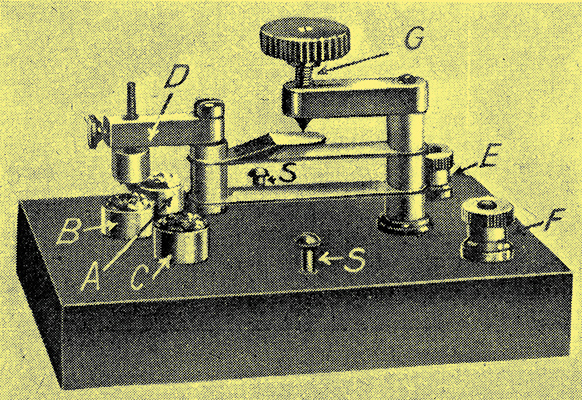
From small beginnings: A Cossor crystal detector, described in Volume 1 of The Wireless World.
On the occasion of our twenty-first birthday we of The Wireless World would naturally like to claims that our journal is 'as old as radio'. But this cannot be: radio-telegraphy was established, albeit precariously, as a commercial means of communication before the first appearance of the journal, although telephony did not become practicable until several years afterwards.
Nowadays, few people seem to realise that the basic principles underlying radio communication were understood more than half a century ago. If they did, they would think twice before repeating the trite inaccuracy that 'wireless is in its infancy', much to the annoyance of those of us who have grown grey - or, worse still, bald - in its service. As long ago as 1873 Clarke Maxwell proved mathematically that electromagnetic waves could be produced, while Hertz, in 1887, actually radiated and detected these waves, measuring their length and velocity. As a detector, he used a minute spark gap connected in series with an oscillatory circuit obviously an extremely insensitive arrangement. The first great stride towards improved reception was made in 1892 by Branly, in France, who invented the coherer, an improved version of the cruder arrangement that was discovered some thirteen years before by Hughes in England. Sir Oliver Lodge, in 1894 repeated some of the Hertzian experiments with improved apparatus, and at about this time Admiral Jackson was doing important pioneer work for the ultimate benefit of our Navy.
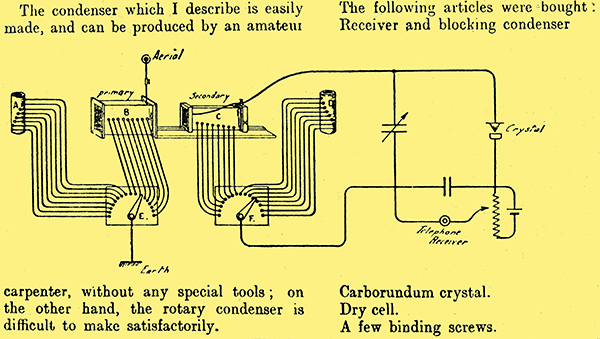
An extract from one of our earliest constructional articles.
So far, wireless as a means of long-distance communication did not exist, and it remained for Guglielmo Marconi, in 1896, to improve the radiating properties of the simple Hertzian oscillator earthing one side of it and elevating the other in-the air as an aerial. With the help of the improved coherer detector intelligible signals could now be exchanged over distances of miles. A year afterwards Sir Oliver Lodge took out what is known as the Syntonic patent, which provided for more persistent oscillations and less interference.
At about this time Marconi was in England, busy with practical experiments. Among his earliest achievements was the linking of the East Goodwin lightship with the land, and, in 1899, the spanning of the English Channel. In the same year a range of eighty-five miles was attained between ship stations, and wireless was used, though with small success, in the South African War.
An important practical development was made by Marconi in the first year of the present century; he patented the coupled-circuit transmitter, which allowed for sharper tuning and the radiation of infinitely more energy than had been possible with the simple 'plain aerial' sets of the past. The first spectacular result of this development was the conquest of the Atlantic, which was spanned by radio-telegraphic signals in 1901. It is true to say that at this time the technique of reception had lagged behind that of transmission, but important developments were soon to come. The years between 1902 and 1906 saw the introduction of the magnetic detector, the Fleming two electrode valve, and crystal rectifiers, all of which were responsible for a considerable increase in the distance over which signals could be interchanged. Range and selectivity were then, as now, the ideals after which everyone concerned in development work were always striving.
In the years immediately preceding the publication of the first number of The Marconigraph, from which The Wireless World evolved, several far-reaching discoveries were made. Lee De Forest, in America, put the third electrode into the Fleming valve; telephony was made possible, theoretically it not practically, by the invention of the arc transmitter and the high-frequency generating machine, and the radiogoniometer, or Wireless direction finder, was evolved by Bellini and Tosi.
When we began publication the position was that the number of land and ship stations - especially the latter - were steadily increasing, and throughout the world several thousand people were directly employed in some capacity or other in wireless communication. There was a regular telegraphic service across the Atlantic, and sets were being installed on aeroplanes and airships. This was the age of spark transmitters, and the high-powered station had already come into being. A wireless station was a wireless station then, giving both visual and audible evidence of its existence; aerial masts of 750 feet in height were soon to appear, and the sudden dissipation of many kilowatts of energy in a crashing and almost awe-inspiring spark discharge was a sound not to be easily forgotten.
Early Amateur Activities
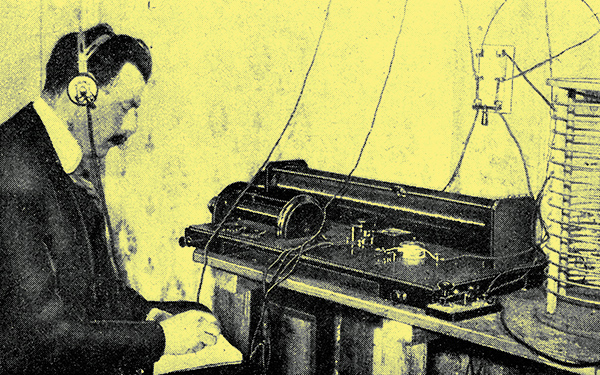
A successful amateur transmitting and receiving station of 1911. The owner, Mr Leslie McMichael, is deeply absorbed in the reception of a message - seldom an easy task in those days.
The amateur movement was already established, but the early enthusiast had to cope with many difficulties. His favourite receiver was a tuner consisting of inductances of gigantic size wound on cardboard tubes, with tappings for variation of inductance, and sometimes, by way of refinement, with a parallel-connected variable capacitor of crude design for fine tuning, The illustration shows a crystal set of the period made by Mr Leslie McMichael, then a prominent figure in the amateur world, and now the Chairman of the Radio Manufacturers Association.
Time signals from Eiffel Tower, with its high aerial, relatively great power, and the low-pitched croaking note of its spark transmitter, were then, the infallible stand-by of every amateur, as the transmissions were easily receivable. The test of a really good set was the ability to receive the German station at Norddeich; except in very favourable circumstances, the thin, piping signals from this station were so weak that one's own breathing seemed loud in comparison.
Wireless seems to thrive on adversity, or, at any rate, to derive benefit from the misfortunes of others, and a great impetus to its development was given by the Titanic disaster in 1912. This great liner struck an iceberg on her maiden voyage to America, and, although there was an appalling loss of life, more than 700 persons were saved, almost certainly by the intermediary of wireless. As a result, it was at last brought home to the public that radio was something more than a scientific novelty.
From now until the outbreak of the World War was a period of steady development, although time was hardly ripe for the commercial application of the three-electrode valve. This device was used in 1911, as an amplifier, by Von Lieben, and, as a generator of continuous oscillations, by Meissner in 1913. Franklin, of the Marconi Company, in the same year applied the principle of plate-grid reaction to the reduction of losses in tuned receiving circuits, and by doing so added enormously to the sensitivity of existing methods of reception.== Continuous waves, as produced by arc generators, had already been modulated in a crude sort of way by water-cooled microphones, or by banks of microphones in parallel, and so telephony had already come into being, but only experimentally, and there was no attempt to broadcast speech and music for general consumption. But time signals were being used by those who were not technically interested in wireless matters.
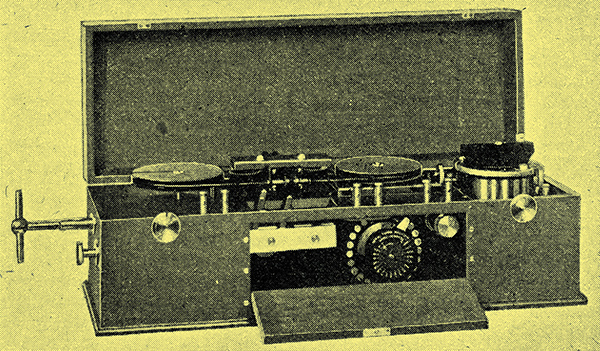
Marconi time-signal receiver, a broadcast set intended for the non-technical user before the advent of telephony.
Wireless and the Great War
In 1913 and 1914 amateur wireless clubs were flourishing, although apparatus was still crude; the triode valve was not yet for Mr Everyman, or, indeed, for anyone except those engaged in important development work. Low-power amateur transmission was in full swing, quite often with the help of a discarded motor bicycle coil as a source of high voltage for the spark transmitter. Detection was still by crystal in most cases, although some of the more advanced amateurs used electrolytic detectors. The design of tuners was rather more refined, but large coils were still the vogue; it was not unusual to specify their inductance by the pound (of wire used in winding them).
Brutal as it may sound, it is a fact that the outbreak of war in 1914 was, like the Titanic disaster, a blessing in disguise for those interested in the practical development of the scientific innovations of the preceding years. All the fighting services of the belligerent nations were clamouring for better radio sets, and plenty of them, and it is probable that twenty years of normal advancement of technique was crammed into the war period.
As all the German cables had been cut at the outbreak of War, that country depended almost entirely on wireless for communicating with the outside World, and especially with America. The activities of the Sayville (Long Island) station were responsible for a certain amount of diplomatic friction between Great Britain and the USA; proof of violation of neutrality was ultimately forthcoming through the ingenuity of an American amateur, who recorded high-speed messages on wax cylinders. As a result, the activities of the station were curbed, and The Wireless World scored a journalistic scoop in November, 1915, by publishing the amateur's own story of how he 'took the say out of Sayville'.
Amateur activities in this country were, of course, entirely stopped at the outbreak of war, and all apparatus had to be deposited with the Post Office authorities. At the time when spy-fever was at its height many who neglected to obey this order found themselves in serious trouble with the authorities, and, in some cases, received sharp sentences. The pirate listener - or even transmitter - who even then was not unknown - found himself in a quandary; to surrender his apparatus amounted to admitting an infringement of the law, while to retain it might mean a much more serious penalty under the Defence of the Realm Act. Even a Morse buzzer was decided to be taboo, and it was seriously suggested in these pages that code practice should be carried out with the blade of a table knife between a pair of dinner plates! Most amateurs found their way into the wireless branches of one or other of the Services, and many of them attained positions of great importance.
Space forbids any attempt to deal, even sketchily, with War-time radio work; the valve amplifier, detector, and oscillator were developed apace, and telephony became practicable.
Immediately after the War came a period of intensive development of long-distance radio-telegraphic circuits, culminating in the building of directional beam stations, which entirely upset the preconceived idea of an Empire wireless chain.
After a good deal of difficulty the amateur was able to recover his pre-war rights, and again set to work in earnest. It was not too easy to acquire a valve - few aspired to more than one and it is to be feared that most of them were obtained through subterranean channels from America, or, more often, through the Army scrounger. Rapid progress was made, culminating in the transatlantic tests of 1921.
Broadcasting, as we know it to-day, started towards the end of 1920 in America, where the Pittsburg station, KDKA, began a series of regular transmissions. Shortly afterwards preliminary steps were taken towards the establishment of a service in this country, and, with the help of the Marconi Company, transmissions were made from stations at Writtle and in London. The BBC started operations at the end of 1922, the same year seeing the opening of the first All British Wireless Exhibition.
From the inception of broadcasting technical improvements succeeded one another so rapidly that it would be impossible to chronicle them here in true perspective. Indeed, it would hardly serve any useful purpose to attempt to do so, as these developments are still fresh in the minds of many of our readers.
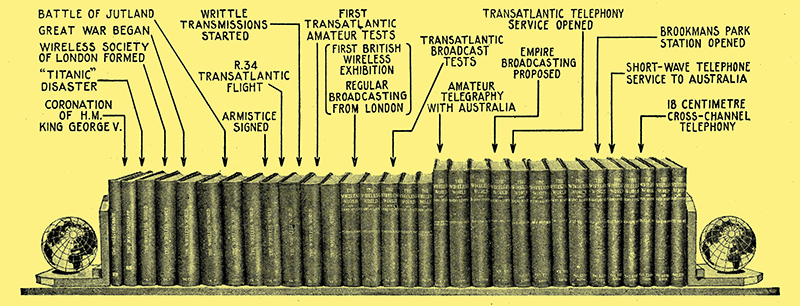
Milestones of the past 21 years of Wireless World.
|